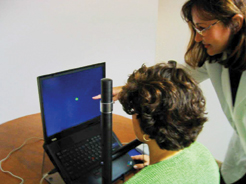A new device, approved by the FDA in April 2003, has shown success in restoring the visual fields of some patients. The treatments acceptance in the United States remains to be seen.
The NovaVision VRT is a computer-based vision restoration therapy already used in Europe. It was approved for the improvement of visual function in patients with homonymous field defects due to trauma, stroke, inflammation, surgical removal of brain tumors or brain surgery. It can also be used for patients with amblyopia.
According to NovaVision, based in Boca Raton, Fla., VRT uses the principle of neuroplasticity, the ability of partially damaged neurons in the brain to compensate for injury and adjust their activity in response to stimulation from the environment.
For each patient, VRT is customized with a sequence of stimuli intended to activate the neurons in the area of the patients brain that shows potential recovery. The stimulus is a small flashing shape that appears on the instruments screen at the border of the patients visual field, with the goal of enlarging the visual field. The patient focuses on a fixation point in the middle of the screen, then taps a button whenever he or she detects the flashing shape. This is done in the patients home for 30-minute intervals twice a day for six months.

VRT appears to enlarge the visual field by training the brain to detect outlying stimuli.
In 1998, NovaVision performed two clinical trials in Europe to test the VRTs efficacy on two groups of patients with visual field defects. The first trial was done on 19 patients with optic nerve damage, and the second was done on 19 patients with post-chiasmatic brain injury. Results showed a 74% improvement in the visual fields of patients in the first group and a 30% improvement in the visual fields in the second group. In total, 95% of the VRT patients showed improvements, and 72% confirmed visual improvements subjectively.1
But, optometrist Eli Peli of Harvard Medical Schools Schepens Eye Research Institute questions the validity of this and other published VRT studies. I find the logic of their explanation doesnt really work, he says. In any hemianopes ... day, hundreds, thousands, maybe millions of visual stimuli cross ... the border between vision and no vision all the time, as he or she moves in the environment and as he or she moves their eyes. So, why would this other stimulation train the visual system?
VRT has been used in the United States for just a few weeks, so U.S. patient data is not yet available.
1. Kasten E, Wust S, Behrens-Bauman W, Sabel, BA. Computer-based training for the treatment of partial blindness. Nat Med 1998 Sep;4(9):1005-6.

